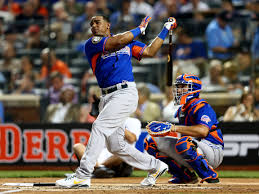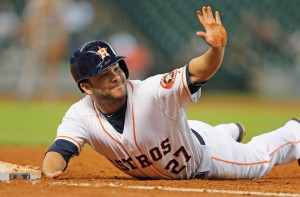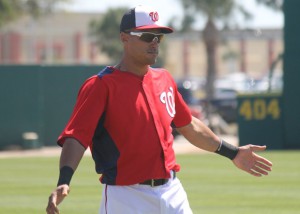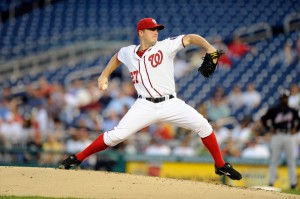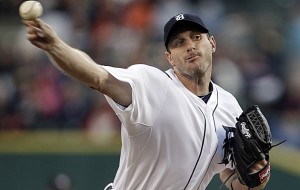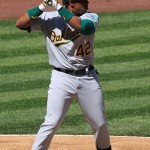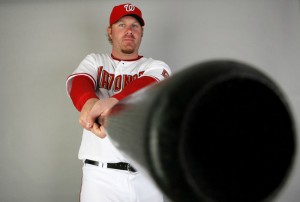I saw a little throw-away post at USAtoday.com before the start of the 2016 baseball season: there were no less than 23 Cuban-born players on MLB rosters on 2016 opening day. And even more defected or were signed in the 2016 calendar year.
How awesome is that? I think its great that we have a huge contingent of Cubans playing in the league again and I wish that a generation hadn’t been lost due to politics. A good percentage of the teams in the majors now have at least one Cuban on their 40-man roster somewhere, and many have multiple IFA Cuban signees scattered in their lower minors. Not the Nats though; we got kinda burned by Yunesky Maya and then blew our IFA budget last year on some D.R. players; perhaps they’ll go after some of the rising talent next July 2 window.
I’ve long hoped for a unification of the Cuban National team to compete in the WBC; I think they’d take so much pride in their team it would really add to the event. However it looks as if the Cuban government will continue to hold a grudge and prevent any defectors from representing their country in the 2017 WBC. The WBC rosters were announced recently, and we’ll see some of these names in the analysis below for reasons that will become apparent soon.
So, since we won’t get a full-strength Cuban WBC team, I thought I’d take a stab at what could have been. I did a similar post in March of 2013 but with all the recent defections the roster looks much improved.
Manager: Fredi Gonzalez of the Atlanta Braves. The only Cuban-born hall of Famer Tony Perez can be the bench coach. They can bring out the likes of Tony Oliva and Camilo Pascual to be his assistants; they’re the most decorated Cuban ex-pros still living.
Pitching Coaches: Livan Hernandez and Orlando “El Duque” Hernandez: the brothers re-unite to teach the staff how to throw junk balls and make starts despite being hooked on Marlboro Reds.
Hitting Coaches: Jose Canseco, Rafael Palmeiro. These two can double as “Strength coaches.” 🙂
Positional Players:
- C: Yasmani Grandal, starting catcher for the Dodgers, 2015 All-Star.
- 1B: Jose Abreu, 91 homers in his first three years in the MLB, Rookie of the Year in 2014, when he also made the All-Star team and won the Silver Slugger.
- 2B: Aledmys Diaz: debut in 2016 and made the All-Star team; prodution fell off so he “only” finished 5th in 2016 Rookie of the Year voting.
- 3B: Adonis Garcia: a solid bat for Atlanta at the corner despite debuting at age 30.
- SS: Jose Iglesias: 2015 All-Star for Detroit after finishing 2nd in RoY voting in 2013.
- LF: Jorge Soler: Flipped to Kansas City this off-season, escaping a log-jam in Chicago. Huge power, yet to reach his potential.
- CF: Yoenis Cespedes: just signed the largest contract of the off-season; not really a CF but played there nonetheless. 2-time All-Star and Home Run derby winner
- RF: Yasiel Puig: despite his demotion in 2016 has the potential to be one of the elite players in the game, which he in-arguably was his first two years in the league. 2015 all-Star.
That’s a pretty solid starting lineup; 6 of the 8 players here have already made a MLB all-star team. Lots of power; you’d probably have a slugger like Soler batting 7th. I think you line these guys up Iglesias, Diaz, Pug, Cespedes, Abreu, Grandal, Soler, Garcia, Pitcher.
Reserves:
- Catcher: Brayan Peña
- Corner Inf/PH: Yonder Alonso , Kendrys Morales, Yulieski Gurriel, Yoan Moncada
- Middle Infield: Yunel Escobar, Adeiny Hechavarria, Alexei Ramirez, Alex Guerrero
- OF: Rusney Castillo, Hector Olivera, Yasmany Tomas, Leonys Martin, Alfredo Despaigne, Yoelkys Céspedes, Victor Mesa
The reserves include a number of solid veteran guys like Alonso and Morales, middle infield cover from the likes of Hechavarria and Ramires, and plenty of OF coverage from players like Tomas and Olivera. And one of the top prospects in all of baseball (Yoan Moncada, the centerpiece of the Chris Sale trade this past off-season) can’t even crack this lineup; he may be your starting 3B before long. Perhaps Gurriel, a decade-long star in the Cuban series, should be starting at third over Garcia; we’ll see how he fares once he gets more time in Houston. Despaigne is the biggest player on this list who still hasn’t come to the MLB: he opted to take up the Cuban government’s relaxing of rules and has been playing in Japan recently. Yoelkys Cespedes is indeed Yoenis’ younger brother and is getting some attention for his abilities already.
Starting Pitchers
- Oridismar Despaigne: he’s been knocked to the bullpen in the Majors, but someone has to start for the Cuban team. Career 4.89 ERA.
- Raisel Iglesias: posted a 2.53 ERA in 2016 as he transitioned from the rotation to closer. He’s gotta start for this team though.
- Roenis Elias: 4th starter for Seattle in 2014-15, struggled/got hurt for Boston in 2016.
- Ariel Miranda : 10 starts for Seattle last year with a 3.54 era; he may not make their rotation in 2017 but he’ll get time.
So, we’re a little light on starters. We may be reaching out to some domestic-based pitchers. Starter Lazaro Blanco just pitched two masterpieces in the Caribbean Series, shutting out the Dominican Republic team for 6 innings then giving up just one run in seven innings in the semis against Mexico. Their #2 and #3 starters (Vladimir Banos and Vladimir Garcia) weren’t half bad either. Freddy Alvarez got pummeled in his only series start but is on the WBC roster as a returning veteran and should see time. Perhaps we should also look at promising 18-yr old Cuban prospect Osvaldo Hernandez, who was just declared a FA and may sign a multi-million dollar deal soon.
Relievers
- Aroldis Chapman (2009 WBC team member): the most dominant reliever in the game, 4-time All-star
- Dalier Hinojosa: setup guy with Philly, decent numbers, like a 6th/7th inning guy.
- Raudel Lazo: lefty reliever with Miami’s farm system; closed for their AAA squad and posted a 1.78 ERA in 2016 in New Orleans.
- Yaisel Sierra: struggled in AA for the Dodgers, demoted to bullpen.
- Armando Rivero, RP for Atlanta
- Yadier Alvarez: LA’s #1 remaining prospect; only in high-A but well regarded.
Past Chapman and Hinojosa, there’s not much depth here either, so again we dip into the domestic-based players. Cuba depended on three late-innings relievers in the Caribbean series: Livan Moinelo, Miguel Lahera and Jose Garcia. All three are named to the official WBC roster.
In summary, the Consoildated all-Cuban team can bash the heck out of the ball … but will struggle on the mound until the 8th or 9th inning when Chapman can take over. But it’d be a fun team to watch play!
Did I miss anyone? Maybe; its impossible to keep track of the dozens of Cuban signings done over the last couple of years. Pipe up if you see someone mising.
Some references used to make this:
- Here’s a direct link to all Cuban-born players in baseball-reference.com.
- 2016 July 2 International signing list
- Here’s the 2017 Cuban Caribbean Series Roster, which may look rather similar to the WBC roster.
- Cuba’s official 2017 WBC roster
- Ben Badler’s top 10 Cuban prospects circa 2015
And Peter Gammons just posted his own version of this the day before I published (but weeks after I wrote this). Compare and contrast his team; i did not cross check to see if I missed anyone.
